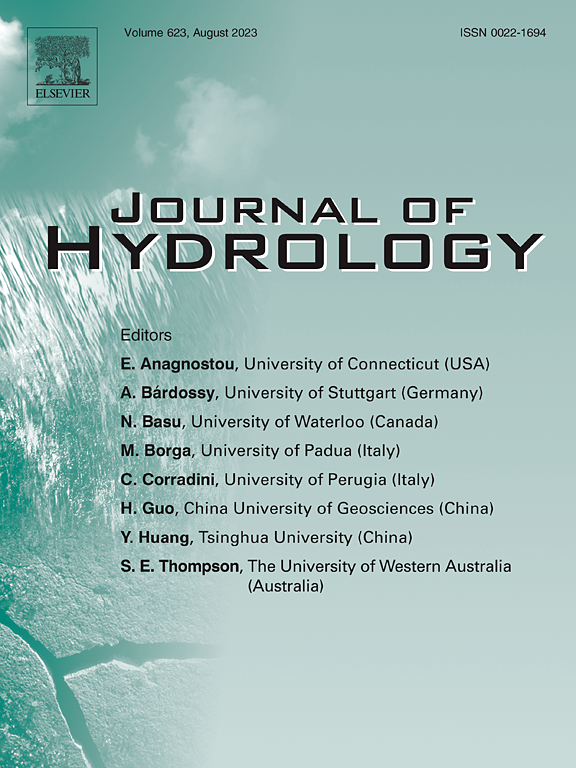利用紧急约束减少中国大陆未来复合干旱和热浪事件的不确定性
IF 5.9
1区 地球科学
Q1 ENGINEERING, CIVIL
引用次数: 0
摘要
近年来,复合干旱和热浪事件的增加已经对全球和中国造成了严重的社会经济影响,引起了越来越多的关注。然而,地球系统模式中潜在的不确定性可能降低极端事件预估的置信水平。以前的研究表明,紧急约束(EC)方法在解决这一问题方面是有效的,而他们主要集中在气候变量或单一极端的处理上。欧共体在降低复合极值不确定性方面的潜力尚未得到充分评价。本文利用24个CMIP6模型,在4种共享社会经济路径(SSP1-2.6、SSP2-4.5、SSP3-7.0和SSP5-8.5)下构建了历史日最高气温与未来(2021-2100)CDHW事件特征(持续时间、严重程度和震级)变化之间的EC关系。在中国大陆的应用表明,与原始预测相比,EC平均将CDHW事件特征的方差降低了35%(持续时间)、25%(严重程度)和21%(震级)。特别地,EC在SSP3-7.0场景下表现最佳,在持续时间、严重程度和幅度上分别减少了42%、32%和29%的方差。到21世纪末,与1981—2010年相比,中国大陆寒流事件的持续时间、严重程度和震级将分别达到8.55(±3.86)~ 31.58(±7.46)天、0.72(±0.25)~ 2.37(±0.57)℃和1.46(±0.56)~ 6.20(±1.65)℃。约束结果表明,CDHW事件持续时间、严重程度和震级分别比目前预期的减少了3.58% ~ 6.00%、2.50% ~ 4.88%和2.48% ~ 4.95%,为复合极端事件的缓解策略和风险评估提供了有价值的见解。本文章由计算机程序翻译,如有差异,请以英文原文为准。
Leveraging emergent constraints to reduce uncertainty in future compound drought and heatwave events across mainland China
Recent increase in compound drought and heatwave (CDHW) events has resulted in serious socio-economic impacts globally as well as in China and attracted growing concern. However, the underlying uncertainty in Earth system models may reduce the confidence levels in extreme events projections. Previous studies demonstrated the effectiveness of the emergent constraint (EC) method in addressing this issue, while they primarily focused on the treatment of climate variables or single extremes. The potential of EC in reducing the uncertainty of compound extremes has not been sufficiently evaluated yet. Here, we construct the EC relationships between historical daily maximum temperature and future (2021–2100) changes of CDHW events characteristics (duration, severity, and magnitude) using 24 CMIP6 models under four Shared Socioeconomic Pathways (SSP1-2.6, SSP2-4.5, SSP3-7.0 and SSP5-8.5). The application in mainland China presented that EC decrease the variance of CDHW events characteristics by 35 % (duration), 25 % (severity) and 21 % (magnitude) on average compared to raw projections. Specially, EC performs best under SSP3-7.0 scenario, with variance reduced by 42 %, 32 % and 29 % for duration, severity, and magnitude, respectively. By the end of 21st century, constrained growth (relative to 1981–2010) in CDHW events duration, severity, and magnitude are projected to reach 8.55 (±3.86)-31.58 (±7.46) days, 0.72 (±0.25)-2.37 (±0.57) ℃ and 1.46 (±0.56)-6.20 (±1.65) ℃, respectively. The constrained results imply that CDHW events duration, severity and magnitude are decreased by 3.58 %-6.00 %, 2.50 %-4.88 % and 2.48 %-4.95 % than currently expected, respectively, providing valuable insights for mitigation strategies and risk assessments of compound extremes.
求助全文
通过发布文献求助,成功后即可免费获取论文全文。
去求助
来源期刊

Journal of Hydrology
地学-地球科学综合
CiteScore
11.00
自引率
12.50%
发文量
1309
审稿时长
7.5 months
期刊介绍:
The Journal of Hydrology publishes original research papers and comprehensive reviews in all the subfields of the hydrological sciences including water based management and policy issues that impact on economics and society. These comprise, but are not limited to the physical, chemical, biogeochemical, stochastic and systems aspects of surface and groundwater hydrology, hydrometeorology and hydrogeology. Relevant topics incorporating the insights and methodologies of disciplines such as climatology, water resource systems, hydraulics, agrohydrology, geomorphology, soil science, instrumentation and remote sensing, civil and environmental engineering are included. Social science perspectives on hydrological problems such as resource and ecological economics, environmental sociology, psychology and behavioural science, management and policy analysis are also invited. Multi-and interdisciplinary analyses of hydrological problems are within scope. The science published in the Journal of Hydrology is relevant to catchment scales rather than exclusively to a local scale or site.
 求助内容:
求助内容: 应助结果提醒方式:
应助结果提醒方式:


